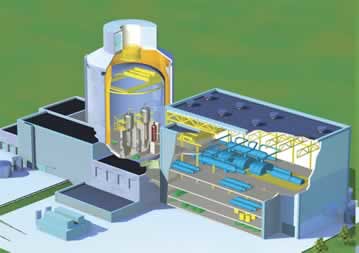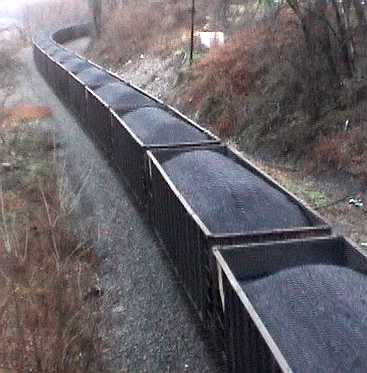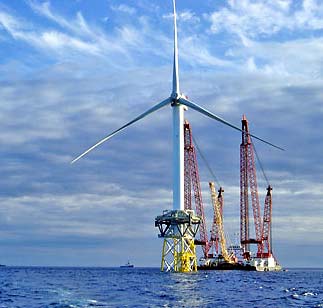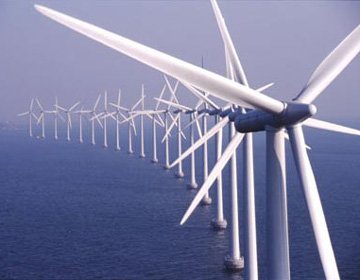One of the common arguments that some in the environmental movement have against nuclear power is “we cannot make enough reactors” and if we do then the price will go up. I will show that historically the world build at a reasonable fast rate (28/year). Currently there are more and more nuclear reactors on order and are being completed at about 8 per year. The material used is a fraction of what is available and will not be a major impact on material prices. The alternatives of coal, wind and hydro also are highly intensive in steel and concrete. The main thing that impacts a nuclear reactors construction cost is length of time to build and interest rates. People do not understand how much steel and concrete is made each year in the world and how many buildings and things are built.
Building 1,000 one gigwatt nuclear plants per year would use less than 10% of the worlds annual concrete and steel. Modern nuclear reactors need less than 40 metric tons of steel and 190 cubic meters of concrete per megawatt of average capacity. 1,000 one gigawatt nuclear plants per year would need 40 million metric tons of steel and 190 million cubic meters of concrete. World supplies in 2006 are 1.24-billion tons of steel per year & 2.283 billion tons of coal per year.
The historical record of plant construction shows that the United States by itself built:
12 nuclear plants were completed in 1974, 10 in 1973, 8 in 1972.
There were years in the eighties with 8 completed. Before 1968 only small reactors were built. Only two had over 400MW, but most were less than 100MW. 1969, 1970, 1971 had 3-4 each year, then in 1972 the 8 reactors. So from a relative standing start the scale up was rapid to the peak of 12/year of the last build cycle. We are in a better position now because US rebuilt a new nuclear plant and is switching on Browns Ferry 1 this year.
May, 2007 global reactor projections are an increase from february, 2007 of 3 being built, 12 planned and 52 proposed. A 21% increase from February. 286 reactors versus 219 reactors are now in the development pipeline.
Schedule about 6-8 completions per year worldwide for next few years.
Why would building more nuclear reactors each year increase costs ? What is the global limiting factors? We can make 100+ coal plants each year. Those as noted are about the same size and use twice as much steel and concrete.
Below are images of coal power plants and nuclear reactors. Notice that they are comparable in size. Coal power plants take 3-4 years to build and are being completed at about 2 per week.

This is a simplified coal plant

A Westinghouse AP1000 cutaway

An actual 1.58GW coal plant near Laughlin, Nevada. Note: each coal plant in the united states kills about 30-300 people from the resulting air pollution. Some plants are more polluting than others. The Laughlin coal plant produces 9 million tons of CO2 each year.
Coal Power plants are a major source of air pollution, with coal-fired power plants spewing 59% of total U.S. sulfur dioxide pollution and 18% of total nitrous oxides every year. Coal-fired power plants are also the largest polluter of toxic mercury pollution5, largest contributor of hazardous air toxics, and release about 50% of particle pollution. Additionally, power plants release over 40% of total U.S. carbon dioxide emissions, a prime contributor to global warming. Power plants are second only to automobiles as the greatest source of NOx emissions

Train loaded with coal, the Laughlin plant needs 42,000 train car loads per year
A 500 MW coal plant each year puts out (triple these numbers for the Laughlin plant):
– 10,000 tons of sulfur dioxide. Sulfur dioxide (SOx) is the main cause of acid rain, which damages forests, lakes and buildings.
– 10,200 tons of nitrogen oxide. Nitrogen oxide (NOx) is a major cause of smog, and also a cause of acid rain.
– 500 tons of small particles which are a health hazard, causing lung damage.
– 125,000 tons of ash and 193,000 tons of sludge from the smokestack scrubber.
– 225 pounds of arsenic, 114 pounds of lead, 4 pounds of cadmium, and many other toxic heavy metal
– 2 tons of Uranium and 6 tons of Thorium

The large Tricastin enrichment plant in France (beyond cooling towers)
The four nuclear reactors in the foreground provide over 3000 MWe power for it.

One Westinghouse AP1000 nuclear reactor

5 megawatt offshore wind turbine, need 600 of these to equal a single 1 gigawatt nuclear reactor (wind has less operating load factor 30% versus 90%. The wind is not always blowing, but nuclear reactions are always happening)

Offshore windfarm
Oil platform size: dimensions of the platform are 103 x 99 meters.
Wind rotor diameters are about 90-100 meters for the 4-6 MW turbines. So wind rotor diameters are about the same width as an oil platform.
During the 70’s and 80’s there were years with 28 nuclear reactors built (1984) worldwide. The cost factors are primarily financing costs. High interests rates in the 1970s and 1980s were not good. Also, delays because of construction skrews ups. But large construction like high rise buildings and ocean liners and freighters are able to go on around the world at a far higher rate than most people understand.
The 434 nuclear reactors around the world are preventing the addition of 10% more global warming gases if that same energy was supplied with fossil fuels.
So it would seem that nuclear reactors are certainly helping to reduce global warming.
Wind and solar are not being built fast enough.
Wind which has been scaling up had a recent report in the Wall Street Journal that they are facing new build constraints. Supply problems. They cannot build as fast as they would like which is still less than the level needed to displace the new coal additions.
Coal is the main power source that will be added in China and the United States over the next few years.
In the USA (the official stats show that http://www.eia.doe.gov/) most of the 30 GW added each year has been natural gas power, but that from 2009 onwards it is shifting to coal power. That coal power will not be built with sequestering. It will mostly be the most polluting version which is pulverized coal.
Modern larger 1.5 GW to 2 GW nuclear reactors can be built. Build them at the old peak rate of 10 to 12 per year and the new coal that would have been added could be displaced.
The construction capacity would be a fraction of the overall building capacity of the US and the world.
World production and consumption of cement totaled 2.283 billion tons in 2005, an increase of about 5.75%, or 124 million tons, over the previous year. (All tonnage figures in this article are metric.) This continues the annual increases we have seen in almost every year since the 1970s.
The world has produced a record 1,24-billion tons of crude steel in 2006, some 8,8% more than in 2005.
1000 one GW nuclear reactors each year would be less than 10% of each of those materials. The steel and concrete used would be less than what is needed for comparable coal and wind.
From Per F. Peterson, Department of Nuclear Engineering. The Future of Nuclear Energy Policy: A California Perspective 2005:
Nuclear power plants built in the 1970’s used
40 metric tons of steel, and 190 cubic meters of concrete,
for each megawatt of average capacity.
Modern wind energy systems, with good wind conditions, take
460 metric tons of steel and 870 cubic meters of concrete per megawatt.
Modern central-station coal plants take
98 metric tons of steel and 160 cubic meters of concrete
—almost double the material needed to build nuclear power plants.
This is due to the massive size of coal plant boilers and pollution control equipment.
Conversely, natural gas combined cycle plants take
3.3 metric tons of steel and 27 cubic meters of concrete—
explaining why natural gas is such an attractive fuel, if it is cheap.
We are running out of natural gas.
The nuclear power plants that we built in the 1970’s were very efficient in their use of steel and concrete. In response to the Three Mile Island accident, however, “bloat” occurred in the designs of new, evolutionary reactors, with steel and concrete inputs increasing by 25 to 50 percent. This is the case for the ABWR, first built in Japan in the 1990’s, and for the EPR, the new European plant design which be built in Finland.
But a major change has occurred with the new nuclear plant designs that will be
built in the United States. These new designs—the ESBWR and the AP-1000—use
passive safety systems, that replace the external cooling supplies, large pumps, and diesel generators used for emergency cooling in the old plant designs with simple, gravity driven heat exchangers. These changes result in large reductions in steel and concrete inputs for these new passive plant designs—actually below the values of our 1970’s plants. Thus we can expect, if they are built in the time periods demonstrated in Japan, that these new nuclear plants can have the lowest construction costs of any reactors every built.
FURTHER READING:
There are high burn reactors which can use up 100% of the fuel instead of 0.7 to 2%.
I have looked at the costs of all energy sources
Money “spent” on nuclear energy was an investment that provided energy for consumers and profit for the companies.
Investment in energy provides energy at a price per kilowatt hour, which is how energy should be compared.
Oil and coal kill 3 million people each year because of air pollution. Oil is about 50% of that. Plus little wars over oil. Japan started WW2 with the USA over lack of access to oil. The Iraq wars.
Electric cars use electricity. So 50% electricity from coal means that half of the electric cars are batteries powered by coal. Electric cars are the way to go but you have to clean up the sources.
I have written a lot about coal
Status of breeder reactors and nuclear waste reprocessing
Look at my past articles on nuclear power
Getting the scope of the energy problem right
Nuclear proliferation has killed no one
There are large uranium supplies
Money available for power infrastructure.
Federal is about 30% of total gov’t spending.
$50 billion per year on infrastructure (1997 $) federal spending.
$175 billion per year infra + Education + r&D federal
10-20% of fed gov’t
3-3.2% of GDP for federal + state + local on infrastructure
0.6-0.7% GDP on power infrastructure
50% on water
25% on transporation
25% on energy
Booz Allen Hamilton has an estimate of $41 trillion from 2005-2030 for urban cities worldwide on infrastructure. World spending is about $300 billion per year on power infrastructure. (2007)
54.7 trillion world economy in 2008.
With the current average of 5% world economic growth, the world economy would be 160 trillion in 2030. The 0.6% of GDP for power infrastructure would go from 328 billion in 2008 to 960 billion in 2030.
Advertising
Trading Futures
Nano Technology
Netbook Technology News
Computer Software
Future Predictions

Brian Wang is a Futurist Thought Leader and a popular Science blogger with 1 million readers per month. His blog Nextbigfuture.com is ranked #1 Science News Blog. It covers many disruptive technology and trends including Space, Robotics, Artificial Intelligence, Medicine, Anti-aging Biotechnology, and Nanotechnology.
Known for identifying cutting edge technologies, he is currently a Co-Founder of a startup and fundraiser for high potential early-stage companies. He is the Head of Research for Allocations for deep technology investments and an Angel Investor at Space Angels.
A frequent speaker at corporations, he has been a TEDx speaker, a Singularity University speaker and guest at numerous interviews for radio and podcasts. He is open to public speaking and advising engagements.



Comments are closed.